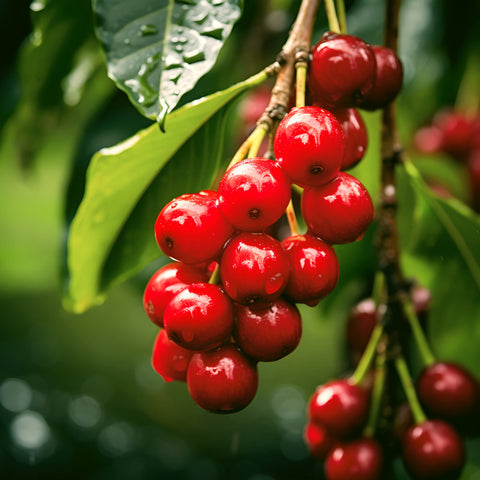The Coffee Plant: A Tropical Wonder
Coffee originates from two primary species of plants: Coffea Arabica and Coffea Canephora, more commonly known as Robusta. These plants belong to the Rubiaceae family and are native to tropical regions of sub-Saharan Africa. Over time, humans have cultivated them in a 'Coffee Belt' or ' Bean Belt' that extends around the world roughly 15-20 degrees north and south of the equator. Spanning around the globe across Central and South America, Africa, Asia, and Oceania.The coffee plant is an evergreen shrub or small tree that typically grows to a height of 9-10 feet, though it can reach up to 30 feet tall in the wild. The plant has simple, glossy, ovate leaves that are dark green in color and provide a beautiful contrast to the white, fragrant flowers that bloom periodically throughout the year.
The Coffee Cherry: A Berry that Fuels the World
Surprisingly, coffee doesn't start as the beans we're familiar with, but as a fruit called the coffee cherry or coffee berry. Each cherry is about the size of a grape, starting as a light green bud and ripening into a bright red or yellow fruit.The anatomy of a coffee cherry is fascinating. It features an outer skin known as the exocarp, a layer of sweet fruit pulp beneath that (mesocarp), followed by a slimy layer called the parenchyma. Underneath this is the endocarp, a parchment-like casing that holds the treasures within: usually two coffee seeds, or beans, nestled together. Some cherries contain a single seed, creating a 'peaberry' – a naturally occurring mutation that many coffee aficionados treasure for its concentrated flavors.
From Seed to Cup: The Coffee Lifecycle
The lifecycle of a coffee bean begins with the planting of the seeds, which are typically pre-germinated in nurseries. After 6-12 months, the seedlings are transplanted to the plantation, often at higher altitudes and under shade, as coffee plants thrive in temperate climates with ample rainfall and no frost.The coffee plants begin to flower in the rainy season, and it takes about six to nine months for the cherries to mature. The cherries are handpicked—primarily due to the uneven ripening of the berries—with most farms having two significant harvests per year.
Once picked, the cherries go through a series of processes, namely 'wetting' or 'drying.' The wet method involves removing the pulp and skin from the cherry, leaving the beans to ferment in water for up to 48 hours. The dry method lets the cherries sun-dry naturally until the moisture level drops to about 11%.
The 'green' beans are then hulled, graded, and sorted before roasting, which is when they transform into the familiar brown beans that we grind and brew.
The Global Coffee Landscape
Coffee cultivation is a delicate balance of climate, altitude, and care that creates a diverse range of flavor profiles unique to each region. Brazilian coffee, for example, is known for its nutty, chocolatey notes, while Ethiopian coffee—often considered the birthplace of coffee—boasts fruity, wine-like flavors.
Despite coffee's African origins, South America now leads global coffee production, with Brazil and Colombia being the largest producers. Vietnam, the top producer of Robusta beans, holds second place globally.
A significant part of the world's economy, coffee cultivation provides livelihoods for millions of small farmers, while also giving rise to a complex network of traders, exporters, roasters, retailers, and baristas around the world.
From the highlands of Colombia to the terrains of Ethiopia, from the volcanic soils of Hawaii to the rainforests of Costa Rica, the journey of coffee is as diverse and rich as the brew it produces. The humble coffee bean, packed with complex flavors and stimulating caffeine, continues to fuel our mornings, power our days, and bring warmth to our conversations. Next time you sip on your cup of joe, take a moment to appreciate the long journey it has made to reach you.
The Santa Barbara Roasting Company: A Global Connection in Every Cup
At Santa Barbara Roasting Company, our role in the journey of coffee begins once the carefully harvested 'green' beans reach our roastery. We proudly import over 16 origins of coffee beans from around the world, creating a global mosaic of flavors within our walls. But it's not merely about importing and roasting coffee - it's about a commitment to quality, ethical sourcing, and the relentless pursuit of exceptional flavor profiles.
Our coffee doesn't come from large-scale, commercial plantations but from exceptional family-owned farms scattered across the 'Coffee Belt'. These farms have been honing their craft for generations, mastering the delicate art of coffee cultivation. We seek out the best of the best - farms that produce high-quality, specialty-grade beans that pack a flavor punch unlike any other.
Beyond quality, our selection of farms is deeply rooted in our commitment to sustainability and social responsibility. We believe in fair trade and pay top dollar for our beans, ensuring that the hard-working farmers who grow our coffee receive a fair price that supports their livelihoods. This approach fosters sustainable farming practices, promotes better social conditions, and enables farmers to invest in quality, leading to a better cup of coffee for us all.
At Santa Barbara Roasting Company, we're not just in the coffee business; we're in the business of crafting experiences, fostering global connections, and promoting sustainability, one cup at a time. So, the next time you enjoy a brew from us, remember - you're not just tasting coffee; you're savoring the culmination of a global journey.



Comments (1)
Any recommendations for your Regular coffee that is low in acid? Thank you.